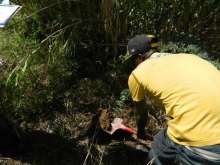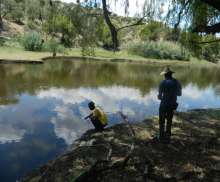Research
"You can't manage what you can't measure"
A range of research has been carried out, and is ongoing, in the Windhoek Green Belt cover aspects including fire, water quality, game numbers and distribution, bush encroachment and more.
Bush encroachment
A baseline study was undertaken in 2013.
» Read the report: A Baseline Study of Bush Encroachment and Available Management options for the Windhoek Green Belt Landscape
Summary:
The report aims to inform stakeholders within WGBL of the available management interventions to combat bush encroachment and monitor progress.
Although emphasis should be placed on the prevention of bush encroachment by treating the root causes, the fact that mature bushes have already encroached on many parts of the WGBL means that these symptoms also need to be treated. Various options for controlling encroached bushes are evaluated by discussing both their positive and negative attributes, suggesting mitigation measures against negative attributes and providing recommendations. The main options considered are the timely application of veld fire, selective stem burning, manual chopping of selected encroached bushes, aerial application of soil-based arboricide and selective manual application of soil-based arboricide. Tebuthiuron is viewed as the most appropriate soil-based arboricide, applied as granules near the base of the target bushes at the start of the rainy season. However, Laggera decurrens is not controlled by Tebuthiuron, and Dichrostachys cinerea requires a higher dosage applied directly at the base of its main stem. An innovative tool, the Tree Popper, is also recommended for levering out small saplings.
Principles to consider when controlling encroached bushes include the avoidance of arboricides if other options are available, the protection of large trees with widespread roots that prevent smaller bushes from growing bigger, and retention of some patches of dense bush to improve biodiversity. In most cases it will be necessary to apply follow-up treatment a few years after the initial control, which often weakens bushes temporarily and/or favours invasion by new bushes. Relevant principles include the use of adaptive management that makes use of opportunities when conditions favour a particular method of control or when invading bushes reach a weak point, and the application of preventative management largely though controlled grazing that maintains the competitive advantage of perennial grasses.
Monitoring is necessary to identify needs and opportunities for timely application of adaptive management, and to determine the level of success of previously applied management. To allow differentiation between changes caused by fluctuating rainfall and changes resulting from bush control, it is useful to compare changes at sites targeted for bush control with changes at reference sites where bushes will not be controlled. Fixed-point photographs provide a visual impression of changes at particular sites. Farmers are encouraged to continue to take photographs from both target sites and reference sites marked with steel Y-posts at the five farms surveyed. The surveys sampled bushes shorter and taller than 1m and perennial grasses, both at the target and reference sites.
Water quality
A water quality assessment was undertaken in 2013.
» Read the report: Water Quality Assessment, Dry Season Results. Weller Consulting Services cc
Summary:
There are a number of industries operating near the landscape which potentially affect the water quality of surface water and groundwater in the landscape. A dry season water quality assessment was undertaken during which soil and water samples were collected from rivers, boreholes, wells throughout the landscape and analysed for mineral salts, nutrients, trace elements and heavy metals.





